No, a ceiling fan will not make your newborn sick, and there is so much to know why. Thus, stick to the article and read it completely to know how the ceiling fan is good for newborns
When you become a parent, you only think of your baby’s health and well-being. When we talk about the health of newborns, there are so many things to consider in the house, but, being a fan blog, we are here to clarify something related to your newborn and the ceiling fan.
You may have heard conflicting opinions about whether ceiling fans are safe for newborns or will ceiling fans make newborns sick. In this comprehensive article, I will address these concerns and provide expert insights on using ceiling fans in your newborn’s room.
Contents
- 1 How is Body Temperature Regulated in Newborns?
- 2 Are Fans Bad for Babies?
- 3 Ideal Ceiling Fan Position in the Newborn’s Room
- 4 Ideal Fan Speed for Newborn
- 5 Benefits of Ceiling Fans for Newborns
- 6 Can Fan Cause Cold in Babies?
- 7 Why Do Babies Like Ceiling Fans?
- 8 Do’s and Don’ts for Using a Ceiling Fan in the Newborn Baby’s Room
- 9 Recommended Size of Ceiling Fan for a Newborn’s Room
- 10 Ideal Room Temperature for a Newborn
- 11 FAQs
- 11.1 Can a ceiling fan cause dry air in the newborn’s room, leading to respiratory issues for newborns?
- 11.2 Is it safe to keep the ceiling fan on during the baby’s sleep, or should it be turned off at specific times?
- 11.3 Should I use the ceiling fan in conjunction with a humidifier in the nursery to maintain the ideal room environment for the baby?
- 12 Conclusion
Before I go ahead, I would like to commit that I am not a health expert so, you should always talk to your doctor for any such concerns. However, one of my friends is a Pediatrics, and he was quite happy to share the knowledge with me when I was talking the other day about the effect of Ceiling fans on newborns.
 I always try to check the facts before writing any article. So, this article includes a Pediatric doctor’s views and my own research, and personal experience since I have a small kid at home as well.
I always try to check the facts before writing any article. So, this article includes a Pediatric doctor’s views and my own research, and personal experience since I have a small kid at home as well.
Let’s dive deep into the topic.
Ceiling fans are designed well to circulate air throughout your room to provide a cool breeze of air. We never think about any health issues related to ceiling fan because it is not produce anything rather it just circulate the air and increases their speed so that we feel cool. But, when it comes to newborn babies who are very fragile, we start thinking about everything around them. Many people think that ceiling fan airflow might not be good for the delicate body of the newborn. But, the truth is quite the opposite. Newborns have a remarkable ability to regulate their body temperature, even better than adults. Their higher surface area to body mass ratio allows them to lose heat faster, making them more adept at adapting to temperature changes. Therefore, a ceiling fan’s gentle airflow is unlikely to make a newborn cold or sick.
How is Body Temperature Regulated in Newborns?
Unlike adults, newborns have an immature thermoregulatory system (That regulates body temperature), making them more vulnerable to temperature changes. Let’s delve into the mechanisms involved in body temperature regulation in newborns and how they adapt to varying environmental conditions.
1. Thermogenesis: Thermogenesis is the process of heat production within the body. This process primarily relies on non-shivering thermogenesis, which involves the breakdown of brown adipose tissue (which is also called brown fat) to generate heat. Brown fat is abundant in newborns, especially preterm infants, and is primarily located around the neck, shoulders, and upper back.
When exposed to cold temperatures, newborns automatically activate their brown fat to produce heat. This helps them maintain a stable body temperature even in colder environments. However, it’s important to note that excessive exposure to cold can deplete the brown fat reserves, leading to potential health risks.
2. Heat Dissipation: In addition to heat production, effective heat dissipation is essential for maintaining body temperature in babies. Newborns have a relatively larger body surface area compared to their body mass, making them more susceptible to heat loss through their skin.
Heat dissipation occurs through four main mechanisms:
- Radiation: Transfer of heat from the baby’s body to surrounding objects, such as walls or furniture.
- Conduction: Transfer of heat from the baby’s body to direct contact surfaces, such as bedding or clothing.
- Convection: Transfer of heat through air currents, such as when a fan blows air across the baby’s skin.
- Evaporation: Loss of heat through sweat and moisture from the baby’s skin.
3. Behavioral Responses: Newborns also have behavioral responses to regulate their body temperature. For example, when they feel cold, they may cry or curl up to minimize heat loss. Similarly, when they feel warm, they may extend their limbs or seek cooler spots in the environment.
4. Environmental Factors: The environment plays a crucial role in influencing a baby’s body temperature. Newborns are more vulnerable to extreme temperatures, whether hot or cold. Therefore, it is essential to maintain a comfortable ambient temperature in the room to support their thermoregulatory capabilities.
5. Adaptation: As babies grow and develop, their thermoregulatory system matures. By the age of around six months, most babies become more proficient at regulating their body temperature and are better able to cope with temperature fluctuations.
So, this was about how newborn’s body temperatures are regulated. Let’s relate it to the ceiling fan.
Are Fans Bad for Babies?
The concern about fans potentially making babies sick is a common worry among new parents. However, when used correctly, ceiling fans are generally safe for newborns, and in fact, they are very good for maintaining a balanced temperature in the room. You just have to ensure the proper positioning of the fan inside the room.
Ideal Ceiling Fan Position in the Newborn’s Room
The ideal position for a ceiling fan in the newborn’s room is crucial to maximize its benefits while ensuring the baby’s safety and comfort. Experts recommend installing the fan at least 8-10 feet off the ground to prevent direct airflow on the baby. Also, make sure to fit the fan in the center of the room which helps distribute airflow evenly throughout the room.

Ideal Fan Speed for Newborn
When setting the fan speed for a newborn’s room, it’s essential to choose a gentle and low setting to create a comfortable breeze. Aim for a fan speed of around 250-350 RPM (revolutions per minute) to provide adequate airflow without overwhelming the baby.
Moreover, it depends how is the temperature in the area you are in. If you are in extremely high temperatures, you have to set your fan at a higher speed to maintain the temperature of the room. But, remember one thing, the faster the fan will rotate, the more sound it will produce which may disturb your newborn’s sleep. Thus, maintain a good balance so that neither it is too slow nor too fast.
What I would suggest for extremely high-temperature areas, is to get an AC, and run it along with Fan to keep the air cool. But, don’t set the temperature too low which will make the room very cool. Just set it at the right temperature as per the hotness in your area, and set the fan at slow speed so that it can distribute the cool air that is coming from AC in the entire room evenly.
Benefits of Ceiling Fans for Newborns
As I clarified above ceiling fans don’t make your newborn sick rather it offers several benefits for newborns and their nursery environment. Some of the advantages include:
- Improved Air Circulation: Ceiling fans help circulate air throughout the room, preventing stale air pockets and ensuring consistent airflow.
- Comfortable Room Temperature: Ceiling fans contribute to a more comfortable room temperature by distributing cool air during warmer months and assisting with heat distribution in colder months. This helps maintain an optimal temperature for the newborn to sleep peacefully.
- White Noise and Soothing Effect: The gentle hum produced by the ceiling fan can create a soothing white noise that masks other environmental sounds. This comforting noise can help the baby go to deep sleep quickly. remember, for such a soothing sound, you must set the fan at slow or medium speed. Fast speed can produce more sound which won’t b good for the newborn.
- Visual Stimulation: You must have seen newborns keep looking at the ceiling fan. right? They often love the movement of the fan’s rotating blades and the patterns of light created. This makes the kid very happy. When my Son was very small, he used to keep looking at the fan all the time. And, when we switch off the fan, he usually gets surprised. So, this is something to keep your newborn engaged as well.
- Sleep Support: Ceiling fans can create a conducive sleep environment by providing a gentle breeze and consistent airflow. This can help regulate the baby’s body temperature and promote longer and more restful sleep.
- Reduces the Risk of SIDS: Many Studies have shown that using a fan in the baby’s room may reduce the risk of Sudden Infant Death Syndrome (SIDS) by almost 72%. Proper air circulation helps prevent the buildup of carbon dioxide around the baby’s crib, reducing the risk of suffocation.
- Energy Efficiency: Ceiling fans are energy-efficient cooling solutions compared to air conditioners. By using a fan in conjunction with an air conditioner, you can maintain a comfortable room temperature while you are able to reduce energy consumption, and thus the electricity bill. If you only use AC, you have to set it for a lower temperature which means it will use its compressor for a longer time which will consume more energy. But, when you couple an AC with a fan, you just have to set AC at a higher temperature just to get some cool air from that, and fan will distribute it well within the room to keep the ambiance cool. And, needless to say that when you set the AC on higher temperatures, it uses its compressor less. Thus, less energy consumption. So, overall, fan helps you cut your electricity bills as well. In fact, if you are not in extremely hot area, you won’t even need an AC. Just a fan would be enough.
Can Fan Cause Cold in Babies?
One common misconception is that a ceiling fan can cause babies to catch a cold. Cool air won’t make your newborn catch cold because cold is caused by viruses, and not by the cool air. As I have mentioned earlier in this article, newborns have an efficient body temperature regulation system, making it highly unlikely for a ceiling fan to lead to illness.
Why Do Babies Like Ceiling Fans?
If you’ve noticed your baby being captivated by the ceiling fan, you’re not alone. Many infants are fascinated by the movement and visual appeal of ceiling fans. The rotating blades and patterns of light can stimulate their developing senses, making ceiling fans a simple source of entertainment for babies.
As I have already mentioned earlier in this article that even I witnessed my son when he was small, kept gazing at the fan for longer durations, and when we switch that off for some time, he looked amazed.
Do’s and Don’ts for Using a Ceiling Fan in the Newborn Baby’s Room
| Do’s | Don’ts |
|---|---|
| Place the fan at least 8 feet above the ground | Don’t install the fan too close to the crib |
| Choose a gentle fan speed (250-350 RPM) | Avoid high fan speeds that create drafts |
| Keep the fan blades clean and dust-free | Don’t use the fan as a substitute for proper bedding and clothing to keep the baby warm |
| Use the fan in combination with proper ventilation and air purifiers for improved air quality | Don’t rely solely on the fan for air quality control |
| Ensure the fan is securely installed and well-maintained | Don’t leave the fan on excessively during colder months or when the baby is not in the room |
Recommended Size of Ceiling Fan for a Newborn’s Room
For optimal air circulation in a newborn’s room, it is recommended to use a ceiling fan with a blade span of at least 36 inches. However, the size may vary depending on the room’s dimensions. Larger rooms may require fans with a larger blade span, ranging from 44 to 54 inches, to ensure effective air circulation.
Ideal Room Temperature for a Newborn
Maintaining an ideal room temperature is crucial for a newborn’s comfort and safety. The recommended room temperature for a newborn’s room should be between 20-22°C. A well-functioning ceiling fan can help regulate the room temperature, preventing it from becoming too hot or stuffy.
FAQs
Can a ceiling fan cause dry air in the newborn’s room, leading to respiratory issues for newborns?
Ceiling fans themselves do not cause dry air in the room. But, in winter air is already dry. In that situation, you can start using a humidifier along with the fan to maintain a comfortable humidity level and reduce the risk of respiratory issues in newborns.
Is it safe to keep the ceiling fan on during the baby’s sleep, or should it be turned off at specific times?
It is generally safe to keep the ceiling fan on during the baby’s sleep. The gentle breeze and soothing white noise can create a comfortable sleep environment. But, if the room is already very cool enough, you can turn the fan off for some time. You can either keep the fan On or Off as per the situation.
Should I use the ceiling fan in conjunction with a humidifier in the nursery to maintain the ideal room environment for the baby?
Yes, you can use a humidifier when the air is dry, usually in winter. Using a ceiling fan with a humidifier can create a balanced and comfortable room environment for newborns. The fan helps distribute humidified air evenly, preventing dry air pockets. You should Aim for a humidity level between 40-60% for a comfortable and healthy room environment for your newborn
Conclusion
Using a ceiling fan in your newborn’s room can be beneficial, as long as proper precautions are taken to ensure safety and comfort. Ceiling fans help improve air circulation, maintain a comfortable room temperature, and create a soothing white noise that aids in better sleep for the baby.
I have included a table of do’s and don’ts in this article which you should consider for a newborn’s room.
Also, every baby is unique, so it’s imperative to observe your baby’s comfort level. Some newborns may feel well even at higher temperatures whereas some may not feel comfortable. So, based on your baby’s comfort level, you can consult your Pediatrics to discuss what would be good for your newborn.
Overall, I would say that Ceiling fans don’t impact badly on your newborn, and don’t make him sick. Rather, when used nicely, it is good for providing constant flow of fresh air to the baby.

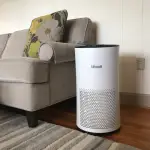
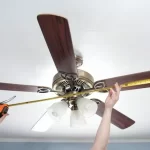
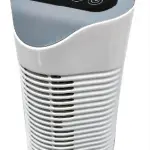

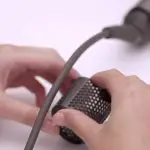

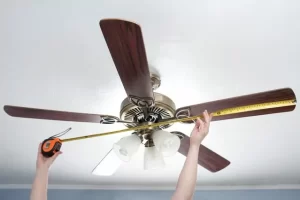
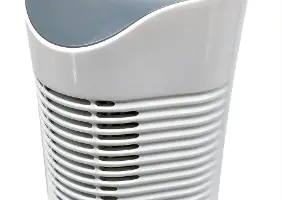
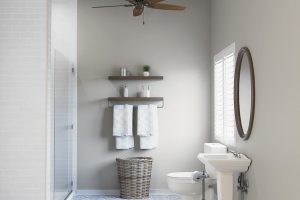
Add Comment